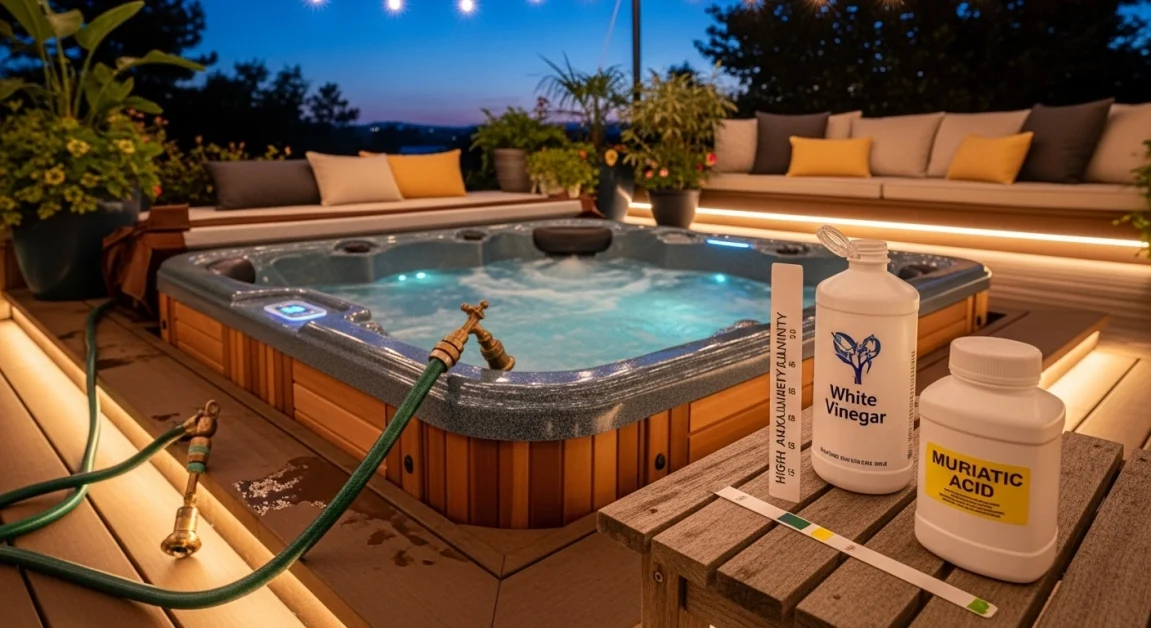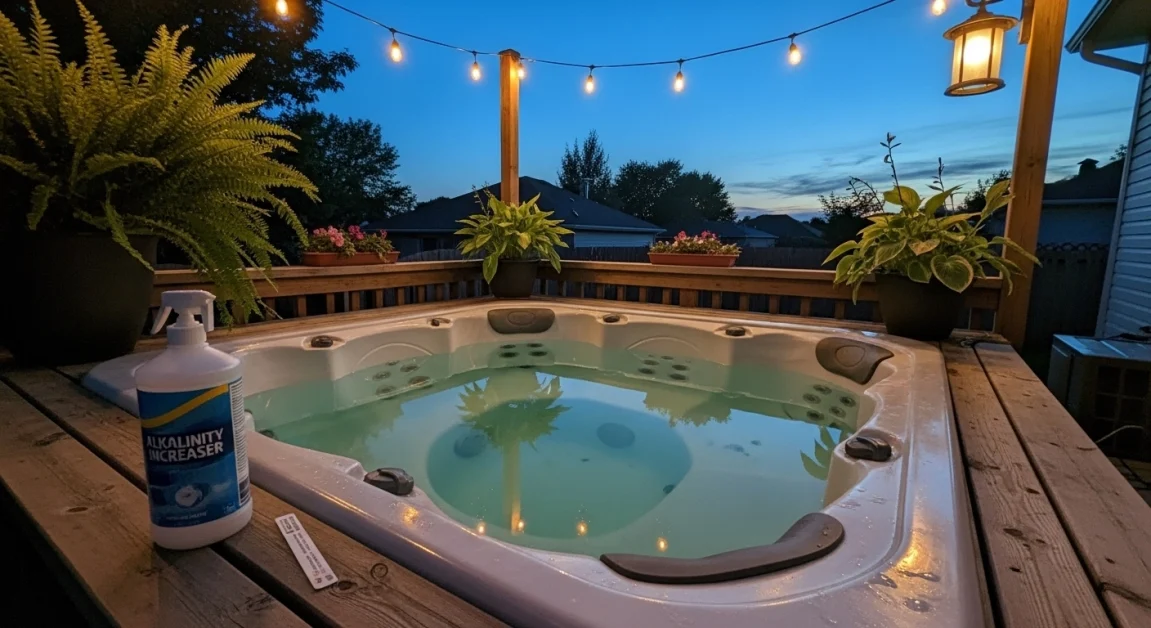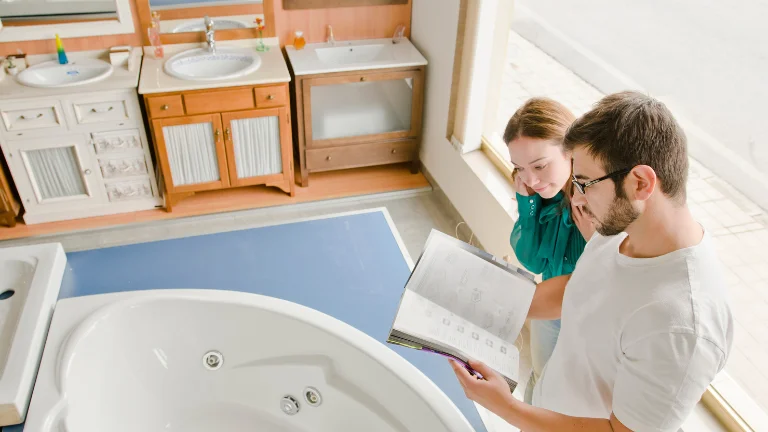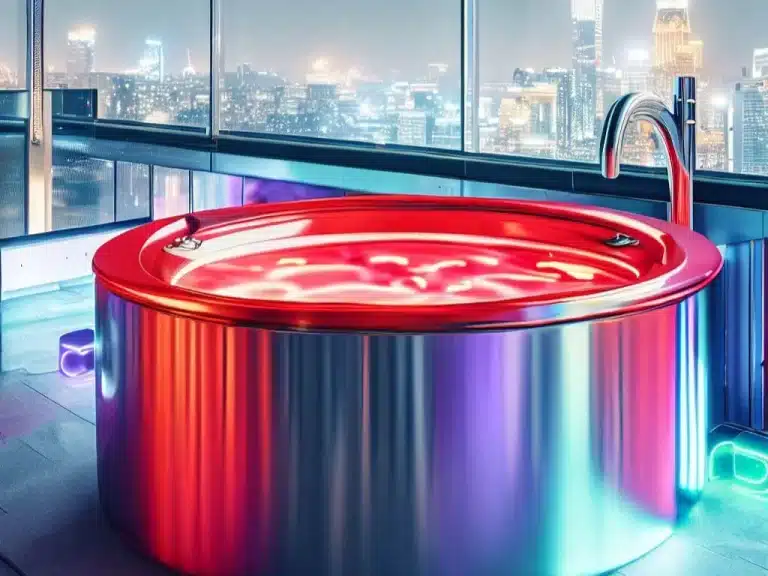Low Alkalinity in Hot Tub? Fix Water Balance Fast
If you’re noticing cloudy water, skin irritation, or equipment issues, your hot tub’s alkalinity might be off. Alkalinity is crucial for maintaining balanced pH levels, which in turn affects water clarity, sanitizer effectiveness, and overall comfort.
NOTE
Maintaining proper alkalinity is key to a safe and enjoyable hot tub experience. Regular testing and adjustments ensure clear water, effective sanitization, and protection for your equipment.
If you’re unsure about your water chemistry, consult with a professional or refer to your hot tub’s manual for specific guidelines.
Lowering Alkalinity with Naturally, Vinegar and Muriatic Acid
High alkalinity (above 120 ppm) makes water feel slimy, scales equipment, and locks pH in place. Here’s how to lower it naturally, with vinegar, or with muriatic acid.

Naturally Lowering Alkalinity
Slower but gentle, these methods avoid harsh chemicals:
- Aeration: Run jets full blast to release carbon dioxide, gradually lowering alkalinity.
- Dilution: Replace 10-20% of water with fresh, low-alkalinity water. Check your tap water’s alkalinity first.
- Natural use: Regular hot tub use (sweat, soaps) can slowly drop alkalinity. Test daily.
Using Vinegar
Vinegar (white distilled) is a mild, household option to lower alkalinity and pH:
- Steps: Add 1 cup per 250 gallons, mix with jets on, wait 4-6 hours, test. Repeat if needed.
- Pros: Cheap, safe, widely available.
- Cons: Slower for high alkalinity, may lower pH too much.
Check Vinegar to Clean Your Hot Tub
Using Muriatic Acid
Muriatic acid is strong and fast, but requires caution:
- Steps: Dilute 1 oz in a bucket of water, add to tub with jets on, wait 4-6 hours, test. Repeat if needed.
- Pros: Quick and effective for high alkalinity.
- Cons: Harsh, can drop pH too low, requires gloves/goggles.
- Safety: Add acid to water (not vice versa), ventilate the area.

Tips for Success
- Test alkalinity (aim for 80-120 ppm) before and after.
- Add small amounts, wait, retest to avoid overshooting.
- Monitor pH, as it may drop and need adjustment.
- Test weekly to keep alkalinity in check.
What Is Alkalinity and Why Does It Matter?
Alkalinity measures the water’s ability to resist pH changes. Think of it as a buffer that stabilizes pH levels. The ideal range for hot tub alkalinity is between 80–120 ppm (parts per million). Some sources suggest a slightly higher range of 100–150 ppm, especially for smaller tubs or those using tablet sanitizers like chlorine or bromine.
Low alkalinity can lead to:
- Corrosion: Metal parts like heaters and jets can erode.
- Skin and eye irritation: Water becomes more acidic.
- pH instability: Frequent fluctuations make balancing difficult.
How to Test and Adjust Alkalinity
- Test the Water: Use test strips or a liquid test kit to measure alkalinity and pH.
- Adjust Alkalinity:
- To Raise: Add sodium bicarbonate (baking soda) or a commercial alkalinity increaser. For example, 1.5 oz of sodium bicarbonate per 100 gallons increases alkalinity by about 10 ppm.
- To Lower: Use sodium bisulfate (pH decreaser) or muriatic acid. Be cautious with acids; add gradually and retest after 24 hours.
- Adjust pH: After stabilizing alkalinity, ensure pH is between 7.2–7.8.

Pro Tips for Maintaining Alkalinity
- Regular Testing: Check water chemistry weekly.
- Proper Filtration: Clean filters monthly to prevent buildup.
- Water Replacement: Drain and refill every 3–4 months.
- Shower Before Use: Reduces contaminants entering the water.
- Limit Additives: Avoid oils, lotions, and fragrances that can disrupt water balance.
ALKALINE WATER:
Alkaline water is the right choice for a healthy hot tub. Alkaline water is low in hot tubs, which helps to keep the pH level balanced and prevents the growth of bacteria. It also helps remove impurities from the water, making it safer for you.

Low Alkalinity in Hot Tub Symptoms
When it’s too low, you’ll see some clear signs. Here’s what low alkalinity looks like in your hot tub:
- Cloudy or weird-colored water: Your spa might look murky or have a greenish vibe. Not exactly inviting for a soak.
- Itchy skin or stinging eyes: You hop out feeling like you rubbed against something prickly. My friend Jake had this issue, and it was low alkalinity messing with his skin.
- Corroded equipment: Acidic water from low alkalinity can chew up metal parts like jets or the heater. You might spot rust or hear odd noises.
- Wild pH swings: Your test strips will show pH bouncing all over, making the water harsh on everything.
What to do about it:
- Test your water’s alkalinity (aim for 80-120 ppm).
- Add an alkalinity increaser (or baking soda if you’re in a pinch, but go easy).
- Retest after a few hours and adjust as needed.
- Check regularly; hot tubs are high-maintenance, but worth it.
How to test and adjust the alkalinity level?
To test the alkalinity level of your hot tub, you will need a test kit or test strips that measure both pH and alkalinity. You can find these at any pool or spa store or online. Follow the instructions on the package to get an accurate reading of your water.
- To adjust the alkalinity level of your hot tub, you will need some chemicals that either lower or raise the alkalinity.
- You can also find these at any pool or spa store or online. Follow the instructions on the package to add the correct amount of chemicals to your water.
- You can use a pH reducer or muriatic acid to lower high alkalinity. These chemicals will also lower the pH level, so you may need to add some pH increaser afterwards to return it to the ideal range.
- To raise low alkalinity, you can use sodium bicarbonate or baking soda. These chemicals will also raise the pH level, so you may need to add some pH reducer afterwards to return it to the ideal range.
You should always test your water before and after adding chemicals to ensure you have achieved the desired results. You should also wait an hour before using your hot tub after adding chemicals.
How to prevent alkalinity problems in your hot tub?
Besides testing and adjusting your water regularly, there are some other steps you can take to prevent alkalinity problems in your hot tub:
- Use products like ProtectPlus to prevent mineral buildup and brominating tablets to control algae and bacteria.
- Drain and refill your hot tub every 3-4 months or as the manufacturer recommends.
- Clean your filter every month or as needed.
- Shower before using your hot tub to remove dirt, sweat, or cosmetics from your body.
- Limit oils, lotions, or fragrances in your hot tub, as they can affect the water chemistry.
- Cover your hot tub when not in use to prevent debris, rain, or snow from entering the water.
Regular maintenance: Keep testing weekly to catch low alkalinity early. A quick tip from Hot Tub Patio’s guide on raising alkalinity is to use a pH stabilizer if you’re worried about pH creeping up while adding baking soda.
Alkaline Water: Health Hype and Hot Tub Help
Does Drinking Alkaline Water Make You Healthier?
Alkaline water, with a pH of 8-9, is less acidic than tap water. Some claim it neutralizes body acid, boosts energy, or prevents disease, but science doesn’t back this up. Your body regulates pH naturally, so alkaline water’s impact is minimal.
It might feel good to drink, especially if it replaces soda, but it’s not a health game-changer. For those with kidney issues, it could even cause problems; check with a doctor first.
Why Acidic Water Spells Trouble for Your Hot Tub
Hot tub water needs a pH of 7.2-7.6. Too low, and acidic water can:
- Etch and fade the tub’s surface, aging it fast.
- Clog or damage filters and pumps.
- Irritates skin and eyes, ruining your soak. Test pH regularly with strips or a kit. If it’s low, add baking soda with jets on, then retest.
Can Alkaline Water Help Your Hot Tub?
Higher alkalinity (80-120 ppm) stabilizes pH, offering benefits:
- Smoother skin: Less acidic water reduces irritation.
- Equipment protection: Prevents corrosion of jets and heaters.
- Comfort boost: May ease inflammation or aid relaxation (anecdotal). Use baking soda or an alkalinity increaser to adjust, not bottled alkaline water.
Tips for Success
- Keep a cover on to block debris and maintain water balance.
- Test alkalinity (80-120 ppm) and pH (7.2-7.6) weekly.
- Adjust with baking soda for low alkalinity or vinegar/muriatic acid for high alkalinity.
- Avoid pricey alkaline water brands, standard products work fine.
🔗 Explore More Hot Tub Resources
Discover everything you need to know about hot tubs, from installation tips to health benefits.
FAQs
For those who have questions or concerns about the safety of their hot tub, contact the manufacturer to ensure it is properly maintained and that all instructions are followed. More studies are being done to see the long-term effects of different types of water on humans. Until then, you can take the advice of this study and use alkaline water when bathing in your hot tub.












3 Comments